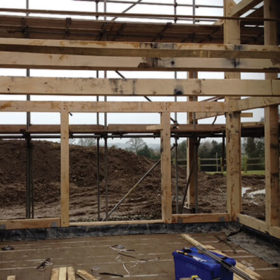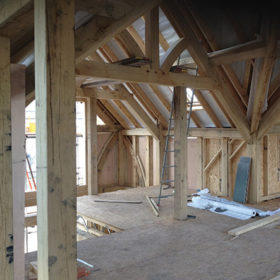
Learn from the experts with our online training course!
Use the code BUILD for 20% off
Learn from the experts with our online training course!
Use the code BUILD for 20% offA mid-project holiday doesn’t slow down Mark and Julia’s self build project
Last weekend I bumped into my neighbour, Chas, who is also building an oak house. I was greeted with the words “If I ever mention self building again, shoot me!” This made me roar with laughter, but I understood what he meant as there’s no doubt that the process gets to you at times. Though it only takes a good result on site the next day and you are flying again – it’s quite an emotional roller coaster.
Julia had booked a holiday long before we had even received planning permission. I thought that a nice two-week spell in the Mexican sunshine would give me some time to catch my breath and plan the next few months of the project ahead of my return. But it was actually really tough for me.
The self build process is full of so many decisions that I must have spent most of the time on my laptop researching and emailing back home. Julia went nuts: “So much for our holiday,” she would yell! I tried so hard to switch off but it’s nigh on impossible; you can’t just turn off the taps on a bespoke home project. A holiday mid-build is not a good idea unless you have a full-time project manager for the scheme.
I have come to realise that the construction world is about making compromises all the way through. What’s on the drawing board does not always translate on site and there will inevitably be a slew of on-the-spot decisions to make.
We are four months in, broadly on schedule and about 5% over my budget – which I can live with. I would strongly suggest that you organise yourself administratively well before you start works. I have developed my own filing process that helps me keep track of: invoices received and paid; invoices received and unpaid; delivery notes; and quotations.
It all sounds simple enough, but believe me when the invoices start rolling in and other paperwork drops through the letterbox, you will be glad that you have a system in place. People will make mistakes and you need to be on your toes at all times checking delivery notes against orders and invoices.
You should also make sure that the discounts you were verbally offered have actually been included on the final bill. It’s amazing how easy it is to forget things and just sign a cheque. I’ve found quotations to be a nightmare, and you can rest assured of getting a few nasty shocks along the way with product prices and labour rates.
Try to familiarise yourself with spreadsheets to summarise suppliers, materials and labour quotes on a single document. Then you’ll have all the details to hand when you need to sign things off.
Just when you thought being on site was the major element of self building you’ll soon realise that research, planning and admin take up just as much of your time and energy.
The frame is now up and it looks absolutely amazing. The felting and battening is in progress and we’re moving on to an exciting stage.
The next phase will involve getting as much of the external work done as possible (brickwork, windows, joinery etc) to effectively close the building in. One of the lads in the office explained that for security reasons alone it’s best to do this to the structure before putting in costly stuff like insulation, copper, electrical cabling and other fittings.
So while all that’s going on I will continue planning, negotiating and getting orders in place for one of the most critical elements of the build – what I call the holy trinity of insulation levels, air tightness and ventilation systems.
For months I have been studying the concept of making buildings airtight. I have read a lot about the advent of Passivhaus and how the Germans and Scandinavians have invested a great deal of time and effort into building technology – so they can concentrate on warmth retention within buildings rather than the efficiency of the heat emitters.
There’s no point having an airtight building if you have no way of managing the stale air. Nor is there any benefit having one if moisture can’t escape out of the structure. A mechanical ventilation and heat recovery system (MVHR) creates movement and balances out warm and cold air within a building. Heat generated while cooking is filtered and redistributed around the home, too, which will save energy.
One of the main features of our house’s design is that a massive section of the south west elevation will be glazed. The solar gain will be huge even in the winter, and so it seemed obvious to me that I should find a way of redistributing this heat around the house, instead of simply letting everything out through the windows.
I know Julia may struggle with this as she does love to air the house out. It’s not just the heat aspect, though: I am slightly asthmatic and in the summer when the pollen count is high I do tend to suffer.
After a lot of searching for the right type of MVHR unit I was fortunate to discover System Air of Oxford, which has an impressive range of products and gave me a superb amount of help. The team worked within my budget and exact requirements, plus their technical backup has been second to none. They have a proven track record in the industry, from handling huge commercial systems in airports to smaller residential installations, too.
The air tightness and moisture control element of this project has been fascinating for me. I’ll admit that it’s proved to be far more technical than I had previously imagined. One firm I found, Ecological Building Systems, has a range of products called Pro Clima dedicated to creating an airtight structure.
The company seems to have a solution for every possible situation where air might seep in our out of the building. This includes tapes, grommets, adhesives and sheet materials. Their most impressive product is an intelligent membrane that allows breathability from the inside, yet is still airtight.
It’s disappointing how little the airtightness of a building and inclusion of a MVHR unit will be taken into account in our final SAP rating. Surely this factor is as important – if not more so – than the adoption of renewable energy sources?
I knew that the cost of insulating the property was going to be hefty, especially if we were going to achieve the low energy performance that I wanted. At the design stage of the project, all of the building’s structural elements were assigned a thermal score on the basis of using products from an approved manufacturer.
Most of the insulation specified for our property is a polyisocyanurate (PIR) based material, which narrowed the search down to a smaller group of suppliers. It is mindboggling to see how many variants there are and it’s all a bit confusing to be honest. The one thing that’s clear, however, is that all the manufacturers work through builders’ merchants and will not sell directly with the public.
So far I would have to say that the most proactive of all the firms is Xtratherm. They came across as hungry and keen to help out. They referred to the term ‘value engineering’ which looks in detail at the whole picture and tries to offer a more cost efficient solution. The specs they’ve offered will certainly help me make savings.
Julia and I have now really started to make ourselves at home on site. The garage is perfect for secure storage, an office and a nice place to sit down for a brew. We even had time to make our first meal in our new home on Sunday – bacon butties!
In the next entry: Mark and Julia have almost completed the external brickwork and their roof tiling is almost finished, too. They’re well on the way to a weathertight structure

